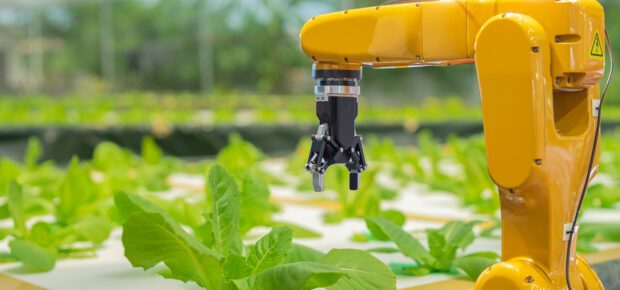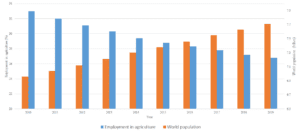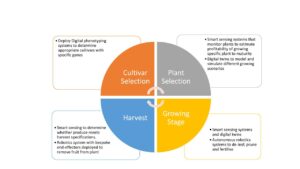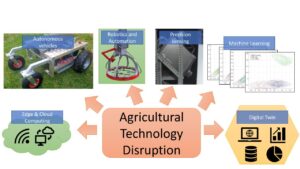July 28, 2021
In the past decade, the agricultural industry has been faced with increasing pressure to produce food with higher requirements on safety and quality while remaining affordable and available in order to feed the world’s growing population. In the years before the COVID-19 pandemic, the industry was under pressure to reduce its use of pesticides while managing a diminishing labor supply.
Figure 1: Employment in agriculture (%) VS World Population (billion) Sources: World Bank; Worldometer
Then COVID-19 occurred, and the unavailability of farm labor went from being a serious concern, to being a critical issue. Today, we are facing food shortages, which drives up prices while unused produce is left to rot on the fields.
The Season for Action
The time is ripe for a disruption to the global food production process. Agricultural technologies have reached a stage where they can provide practical solutions to resolve this major global challenge. Autonomous vehicles, be they ground or air, once were a dream. Now they are a reality, with sophisticated geographical positioning systems integrated with precision sensing and artificial intelligence.
Starting at the cultivar selection stage, deployment of hyperspectral vision systems with statistical machine learning has paved the way for an upcoming field known as digital phenotyping. Sensors, in other words, can identify plants based on the electromagnetic signature they create –– much like the way humans identify plants by their size, shape or structure.
This technology helps accelerate breeding programs that assist plant physiologists in identifying cultivars with disease –– and/or climate-resilient genes. Selected cultivars are then grown with smart sensing systems that record and monitor their growth. When used with digital twin technology, it is able to simulate how different business decisions affect the crop yield without actual physical “test and see” seasons.
The growing stage of the plants is the most labor-intensive part of the cultivation process. There are numerous manual tasks currently performed, such as de-leafing, spraying, pruning, weeding and layering. The summer season generally requires more labor, and yet this is when the working conditions are the harshest.
A farm worker manually de-leafs tomato plants in a hot and humid glasshouse. This process is crucial to ensure the best size and quantity of harvest. Imagine hundreds of thousands of plants to de-leaf every week during the summer season, and the shortage of labor means that thousands of plants are left unattended, leading to lower supply of food down the line.
Sensing, Working and Learning
The wide availability of new robotics and automation technologies can be deployed to perform these manual and monotonous farming tasks. Imagine autonomous vehicles that drive around the rows of farmland while pruning and weeding, simultaneously performing digital evaluations of plant growth.
Environmental and physical data of the farmland and produce can then be used, for example, to indicate which fertilizer works best or how much pruning needs to be done, or what irrigation cycle provides higher crop yield. Not only can this data be visualized on a computer screen for farm owners, the autonomous system can order components of the system to take action.
Figure 2: Types of technologies used at different stages of food production
The culmination point is at harvest, and there is little wiggle room with regards to the optimal picking time. The travel restrictions brought by COVID-19are severely disrupting the typical influx of back-packers and seasonal workers.
Smart technologies can work together to perform autonomous harvesting and hence help alleviate the impact of worker shortage.
Harvesting a Food Revolution
In the video above, we see this system in action. An intelligent vision system powered by machine learning algorithms first locates the fruit. Once a fruit is located, it sends coordinates to the arm, which deploys a bespoke end-effector to the given position. Another smart sensor unit sits on the end-effector to estimate fruit size and ripeness. If determined to be harvest-ready, the end-effector goes on to pick up the fruit, and then drops it off either into a crate or conveyor belt depending on the design of the harvester system. Many developments in control systems and robotics have managed to capture the essence of human motion for fruit-picking such as cutting, plucking, rolling, pinching, breaking and twisting. The beauty of this robot evolution is the consistency in robot decision-making which leads to crop consistency, higher product yield and better quality of produce.
Smart systems are now increasingly prevalent in the farmlands and through them, we can expect to achieve higher food security and sustainability, and ultimately Zero Hunger by 2030.
Figure 3: New agricultural technologies paving the way towards Zero Hunger
ABOUT OUR AUTHOR
Melanie Ooi is an IEEE Senior member and member of the IEEE Instrumentation & Measurement Society, 2016-17 Distinguished Lecturer for the IEEE Instrumentation and Measurement Society, and the 2014 Outstanding Young Engineer Award from the IEEE Instrumentation and Measurement Society.
Shen Hin Lim is an IEEE member and a member of the IEEE Robotics & Automation Society.
If you wanted to build an automated greenhouse that balanced water and energy needs, where would you start? This paper maps out the decision matrix for building a greenhouse powered by renewable energy.







 Meaningful Momentum or Running in Place?
Meaningful Momentum or Running in Place? AI Through Our Ages
AI Through Our Ages Liquid Infrastructure: Our Planet's Most Precious Resource
Liquid Infrastructure: Our Planet's Most Precious Resource The Impact of Technology in 2025
The Impact of Technology in 2025 Quantum and AI: Safeguards or Threats to Cybersecurity?
Quantum and AI: Safeguards or Threats to Cybersecurity? Why AI Can't Live Without Us
Why AI Can't Live Without Us Bits, Bytes, Buildings and Bridges: Digital-Driven Infrastructure
Bits, Bytes, Buildings and Bridges: Digital-Driven Infrastructure Impact of Technology in 2024
Impact of Technology in 2024 Emerging AI Cybersecurity Challenges and Solutions
Emerging AI Cybersecurity Challenges and Solutions The Skies are Unlimited
The Skies are Unlimited Smart Cities 2030: How Tech is Reshaping Urbanscapes
Smart Cities 2030: How Tech is Reshaping Urbanscapes Impact of Technology 2023
Impact of Technology 2023 Cybersecurity for Life-Changing Innovations
Cybersecurity for Life-Changing Innovations Smarter Wearables Healthier Life
Smarter Wearables Healthier Life Infrastructure In Motion
Infrastructure In Motion The Impact of Tech in 2022 and Beyond
The Impact of Tech in 2022 and Beyond Cybersecurity, Technology and Protecting Our World
Cybersecurity, Technology and Protecting Our World How Technology Helps us Understand Our Health and Wellness
How Technology Helps us Understand Our Health and Wellness The Resilience of Humanity
The Resilience of Humanity Harnessing and Sustaining our Natural Resources
Harnessing and Sustaining our Natural Resources Creating Healthy Spaces Through Technology
Creating Healthy Spaces Through Technology Exceptional Infrastructure Challenges, Technology and Humanity
Exceptional Infrastructure Challenges, Technology and Humanity The Global Impact of IEEE's 802 Standards
The Global Impact of IEEE's 802 Standards Scenes of our Cyber Lives: The Security Threats and Technology Solutions Protecting Us
Scenes of our Cyber Lives: The Security Threats and Technology Solutions Protecting Us How Millennial Parents are Embracing Health and Wellness Technologies for Their Generation Alpha Kids
How Millennial Parents are Embracing Health and Wellness Technologies for Their Generation Alpha Kids Space Exploration, Technology and Our Lives
Space Exploration, Technology and Our Lives Global Innovation and the Environment
Global Innovation and the Environment How Technology, Privacy and Security are Changing Each Other (And Us)
How Technology, Privacy and Security are Changing Each Other (And Us) Find us in booth 31506, LVCC South Hall 3 and experience the Technology Moon Walk
Find us in booth 31506, LVCC South Hall 3 and experience the Technology Moon Walk Virtual and Mixed Reality
Virtual and Mixed Reality How Robots are Improving our Health
How Robots are Improving our Health IEEE Experts and the Robots They are Teaching
IEEE Experts and the Robots They are Teaching See how millennial parents around the world see AI impacting the lives of their tech-infused offspring
See how millennial parents around the world see AI impacting the lives of their tech-infused offspring Take the journey from farm to table and learn how IoT will help us reach the rising demand for food production
Take the journey from farm to table and learn how IoT will help us reach the rising demand for food production Watch technical experts discuss the latest cyber threats
Watch technical experts discuss the latest cyber threats Explore how researchers, teachers, explorers, healthcare and medical professionals use immersive technologies
Explore how researchers, teachers, explorers, healthcare and medical professionals use immersive technologies Follow the timeline to see how Generation AI will be impacted by technology
Follow the timeline to see how Generation AI will be impacted by technology Learn how your IoT data can be used by experiencing a day in a connected life
Learn how your IoT data can be used by experiencing a day in a connected life Listen to technical experts discuss the biggest security threats today
Listen to technical experts discuss the biggest security threats today See how tech has influenced and evolved with the Games
See how tech has influenced and evolved with the Games Enter our virtual home to explore the IoT (Internet of Things) technologies
Enter our virtual home to explore the IoT (Internet of Things) technologies Explore an interactive map showcasing exciting innovations in robotics
Explore an interactive map showcasing exciting innovations in robotics Interactively explore A.I. in recent Hollywood movies
Interactively explore A.I. in recent Hollywood movies Get immersed in technologies that will improve patients' lives
Get immersed in technologies that will improve patients' lives